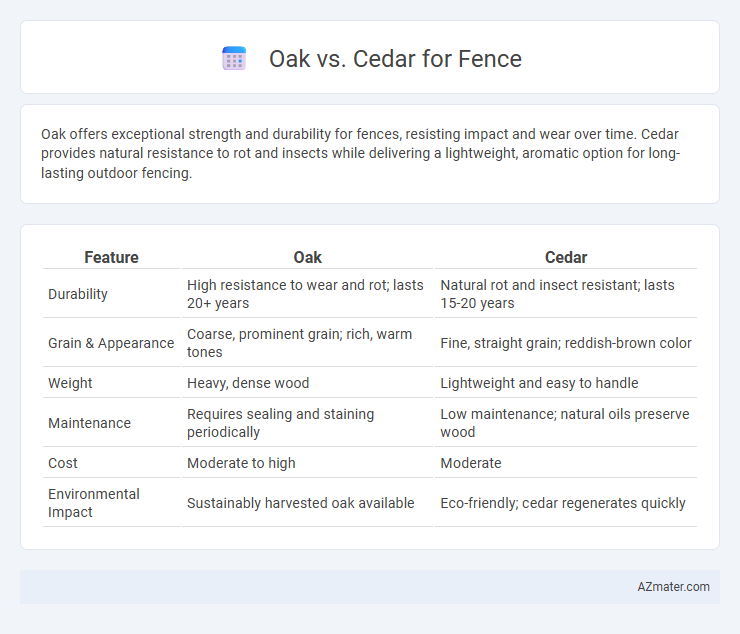Oak offers exceptional strength and durability for fences, resisting impact and wear over time. Cedar provides natural resistance to rot and insects while delivering a lightweight, aromatic option for long-lasting outdoor fencing.
Table of Comparison
| Feature | Oak | Cedar |
|---|---|---|
| Durability | High resistance to wear and rot; lasts 20+ years | Natural rot and insect resistant; lasts 15-20 years |
| Grain & Appearance | Coarse, prominent grain; rich, warm tones | Fine, straight grain; reddish-brown color |
| Weight | Heavy, dense wood | Lightweight and easy to handle |
| Maintenance | Requires sealing and staining periodically | Low maintenance; natural oils preserve wood |
| Cost | Moderate to high | Moderate |
| Environmental Impact | Sustainably harvested oak available | Eco-friendly; cedar regenerates quickly |
Introduction: Oak vs Cedar for Fencing
Oak and cedar are two popular wood choices for fencing, each offering distinct advantages in durability and appearance. Oak provides exceptional strength and resistance to wear, making it ideal for heavy-duty fences, while cedar naturally repels insects and resists rot, ensuring longevity with minimal maintenance. Selecting between oak and cedar depends on priorities such as budget, climate, and desired aesthetic.
Durability Comparison: Oak and Cedar
Oak offers exceptional durability with a dense, hard grain that resists impact and wear, making it ideal for long-lasting fence structures. Cedar provides natural resistance to decay and insects due to its aromatic oils, ensuring longevity without heavy chemical treatments. While oak requires sealing to prevent moisture damage, cedar maintains structural integrity with minimal maintenance, especially in damp or variable climates.
Weather Resistance: Oak vs Cedar
Cedar exhibits superior weather resistance compared to oak due to its natural oils and tight grain, which repel moisture and resist decay, making it ideal for humid or rainy climates. Oak, while strong and durable, tends to absorb more water and is more prone to warping and rot without proper sealing and maintenance. Cedar's inherent resistance to insects and fungal growth further enhances its longevity for outdoor fencing applications.
Aesthetic Appeal and Grain Differences
Oak fences offer a bold, prominent grain with deep, rich hues that enhance traditional and rustic aesthetics, while cedar fences feature a finer, straighter grain and warm reddish tones that create a smooth, natural look. Cedar's aromatic qualities and natural resistance to decay complement its aesthetic appeal, emphasizing longevity alongside beauty. Oak's coarse texture and pronounced grain patterns provide a sturdy, rugged appearance favored in classic, durable fence designs.
Maintenance Requirements of Oak and Cedar
Oak fences require regular sealing or staining to prevent moisture damage and maintain their durability, as oak is prone to warping and splitting when exposed to prolonged wet conditions. Cedar fences are naturally resistant to rot, decay, and insect infestations, demanding less frequent maintenance but occasional cleaning and reapplication of protective coatings to preserve color and structural integrity. Both woods benefit from periodic inspection for damage, though cedar's inherent oils reduce the need for extensive upkeep compared to the more maintenance-intensive oak.
Cost Considerations: Upfront and Long-Term
Oak fences demand higher upfront costs due to dense hardwood and labor-intensive installation, but offer exceptional durability minimizing future repairs. Cedar fences present a moderate initial investment with natural resistance to decay and insects, reducing maintenance expenses over time. Evaluating long-term value, oak provides lasting strength, whereas cedar balances cost and natural protection for sustainable fencing.
Environmental Impact and Sustainability
Oak fencing offers high durability and long lifespan, reducing the need for frequent replacements and lowering overall environmental impact through resource conservation. Cedar is naturally resistant to decay and pests, minimizing the use of chemical treatments that can harm ecosystems, making it a sustainable choice for eco-friendly fencing. Both woods are renewable when sourced from responsibly managed forests, with cedar generally having a smaller carbon footprint due to faster growth rates and lighter weight.
Pest and Rot Resistance
Cedar fences offer superior natural pest and rot resistance due to their aromatic oils that repel insects and moisture, making them ideal for long-lasting, low-maintenance fencing. Oak, while strong and durable, is more susceptible to insect infestations and rot without proper treatment or sealing. Choosing cedar over oak can significantly reduce the need for chemical preservatives and frequent repairs in environments prone to high humidity and pest activity.
Installation and Workability
Oak fences require more effort during installation due to the wood's density and hardness, making cutting and nailing more challenging. Cedar wood offers greater workability with its lighter weight and natural resistance to splitting, allowing faster and easier handling by installers. Both woods provide durable options, but cedar's ease of installation often reduces labor time and overall project costs.
Best Applications: Choosing Oak or Cedar for Your Fence
Oak offers exceptional strength and durability, making it ideal for fencing that requires robust protection and long-lasting performance in high-traffic or exposed areas. Cedar is naturally resistant to rot and insects, providing a lightweight yet weather-resistant option perfect for decorative or privacy fences in moderate climates. Selecting between oak and cedar depends on your priorities for strength versus natural resistance, as oak excels in structural integrity while cedar offers superior decay and pest resistance.

Infographic: Oak vs Cedar for Fence
 azmater.com
azmater.com